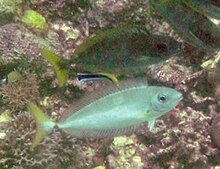Naso minor, the blackspine unicornfish, slender unicornfish, lesser unicornfish or pony unicornfish, is a species of marine ray-finned fish belonging to the family Acanthuridae, the surgeonfishes, unicornfishes and tangs. This species is found in the Indo-Pacific region.
| Naso minor | |
|---|---|

| |
| Naso minor, Romblon, Philippines | |
| Scientific classification | |
| Domain: | Eukaryota |
| Kingdom: | Animalia |
| Phylum: | Chordata |
| Class: | Actinopterygii |
| Order: | Acanthuriformes |
| Family: | Acanthuridae |
| Genus: | Naso |
| Subgenus: | Axinurus |
| Species: | N. minor
|
| Binomial name | |
| Naso minor (J. L. B. Smith, 1966)
| |
| Synonyms[2] | |
| |
Taxonomy edit
Naso minor was first formally described in 1966 by the South African ichthyologist James Leonard Brierley Smith with its type locality given as Pinda Reef in Mozambique.[3] This species is classified in the subgenus Axinurus within the genus Naso. [4] The genus Naso is the only genus in the subfamily Nasinae in the family Acanthuridae.[5]
Etymology edit
Naso minor is the smallest species in the genus Naso hence the specific name minor.[4]
Description edit
Naso minor has its dorsal fin supported by 5 spines and 27 to 29 soft rays while the anal fin is supported by 2 spines and between 27 and 29 soft rays. This is a relatively slender unicornfish with the standard length being around three times the body's depth. The head does not have any form of protuberance and is smoothly rounded. There is a short, diagonal groove in front of the eye and below the nostrils. There is a single bony plate on each side of the caudal peduncle and this has a large keel and a forward pointing spine. The overall colour is grey fading to white on the underside with a purplish-grey head. It can show 5 or 6 bluish grey horizontal stripes along the flanks. The lips are blackish, there is an area of lighter colour underneath the pectoral fins, the bony plates and the caudal peduncle are black and the caudal fin is yellow. When courting the males have a black upper body and a white stripe along the flanks.[6] This species has a maximum published standard length of 30 cm (12 in).[2]
Distribution and habitat edit
Naso minor has a wide but somewhat localised distribution in the Indian Ocean but is slightly less scattered in the western Pacific Ocean. It has been recorded from Mozambique, Mauritius[1] and Reunion[6] in the western Indian Ocean. In the Western Pacific Ocean it has been recorded from eastern Indonesia and the Philippines north to Taiwan, south to Australia and east to Guam.[1] In Australia it is found from the northern Great Barrier Reef south to the waters off Cairns.[7] The slender unicornfish is found from coastal reefs to the outer reef slopes, typically swimming around the upper edges of drop-offs in small groups.[2]
Biology edit
Naso minor feeds on zooplankton in the water column at depths between 8 and 40 m (26 and 131 ft)[1] and close to reefs. They will move onto reefs to be cleaned by the bluestreak cleaner wrasse (Labroides dimidiatus). The males can rapidly change their colour and pattern when courting females.[2]
References edit
- ^ a b c d Abesamis, R.; Clements, K.D.; Choat, J.H.; et al. (2012). "Naso minor". IUCN Red List of Threatened Species. 2012: e.T177975A1508588. doi:10.2305/IUCN.UK.2012.RLTS.T177975A1508588.en.
- ^ a b c d Froese, Rainer; Pauly, Daniel (eds.) (2023). "Naso minor" in FishBase. June 2023 version.
- ^ Eschmeyer, William N.; Fricke, Ron & van der Laan, Richard (eds.). "Species in the genus Naso". Catalog of Fishes. California Academy of Sciences. Retrieved 31 July 2023.
- ^ a b Christopher Scharpf & Kenneth J. Lazara, eds. (12 January 2021). "Order ACANTHURIFORMES (part 2): Families EPHIPPIDAE, LEIOGNATHIDAE, SCATOPHAGIDAE, ANTIGONIIDAE, SIGANIDAE, CAPROIDAE, LUVARIDAE, ZANCLIDAE and ACANTHURIDAE". The ETYFish Project Fish Name Etymology Database. Christopher Scharpf and Kenneth J. Lazara. Retrieved 31 July 2023.
- ^ J. S. Nelson; T. C. Grande; M. V. H. Wilson (2016). Fishes of the World (5th ed.). Wiley. pp. 497–502. ISBN 978-1-118-34233-6.
- ^ a b John E. Randall (2022). "Family Acanthuridae". In Phillip C Heemstra; Elaine Heemstra; David A Ebert; Wouter Holleman; John E Randall (eds.). Coastal Fishes of the Western Indian Ocean (PDF). Vol. 5. South African Institute for Aquatic Biodiversity. pp. 219–244. ISBN 978-1-990951-32-9. Archived (PDF) from the original on 2023-06-12. Retrieved 2023-07-17.
- ^ Dianne J. Bray. "Naso minor". Fishes of Australia. Museums Victoria. Retrieved 1 August 2023.
External links edit
- Photos of Naso minor on Sealife Collection
